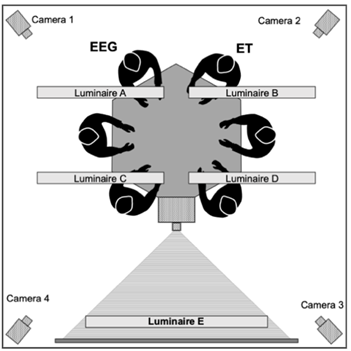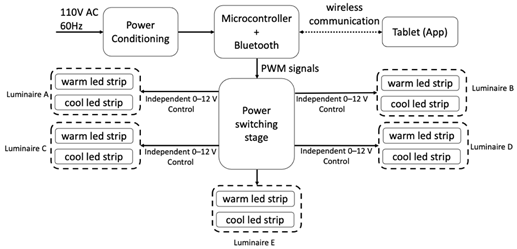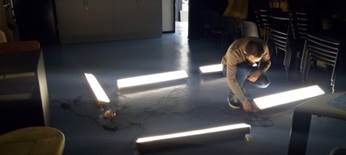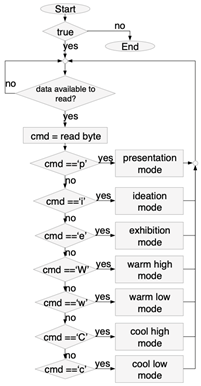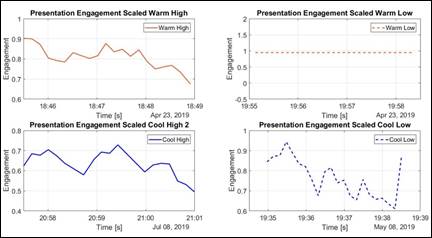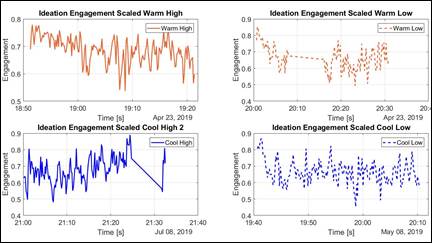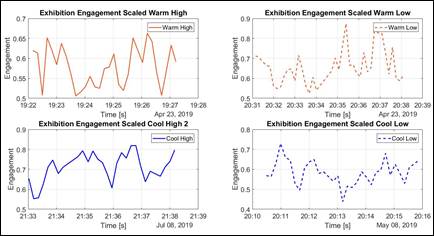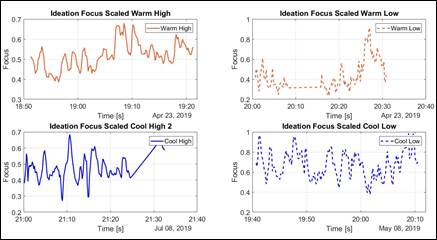I. INTRODUCTION
Classroom lighting is one of the most important aspects for both teachers and students, because it has a great impact on health, productivity and alertness levels [1, 2]. It has been widely demonstrated that visual comfort in classrooms is a crucial factor for learning because enhances the educational process [3, 4]. An educational process requires multiple activities to influence the mental and physical state of a person, aiming to provide specific knowledge, skills and abilities. For the case of industrial design students, specific activities are required in the classroom, mainly the presentation of projects, sketching, elaboration of models, prototyping and exhibition, which involve different ways of constructing mental representations of the ideas generated [5]. The development of skills of these representation modes are fundamental for learning design processes, which imply the construction of attention networks that are indispensable during the design phase of the project.
Based on multiple ergonomics research, illuminance and correlated color temperature are the two main photometric variables, which affect people’s visual comfort, visual function and task performance [6, 7]. In [8], the authors evaluated the effects of different color temperature levels on visual comfort, alertness and preferences of students in Faculty of Medicine and Health Sciences, concluding that cool white light (4000 K) and artificial daylight (6500 K) were more beneficial for alertness levels and academically activities for both computer-based and paper- based activities. In [9-16], lighting control systems are proposed to reduce power consumption by switching or dimming lighting in particular areas of the classroom. In [17,18], an intelligent lighting system was developed for a typical office environment to evaluate the perception of work-related productivity, efficiency and fatigue of the occupants working on site. In [19] a lighting control system capable of adjusting illuminance, uniformity and correlated color temperature according to students needs was evaluated.
Most of these dynamic lighting systems DLS are focused on reducing power consumption, considering health, productivity and alertness levels of students and employees. Only few studies have focused on evaluating lighting conditions for an educational environment considering the activities that are developed according to the discipline that is being taught [20,21]. Multiple visual activities are performed within the classroom such as reading and writing on the desk, writing on the classroom board, sketching, hearing and making presentations, building models, making prototypes, communicating between students and teachers, among others. These activities can vary considerably according to the subject being taught and the student’s profession, and that is why they require specific lighting conditions in order to be successfully performed.
Within this framework, the present study aims to evaluate the incidence of lighting in the sustained and fixed attention of design students during the development of their main activities listed above. A dynamic lighting system DLS is proposed to configure illuminance and the correlated color temperature conditions in order to provide better visual conditions for the case of industrial design students according to the specific activities that are being done.
This article is divided as follows: Section II presents a description of the methodology, Section III presents the results, Section IV presents the discussion, and Section V presents the conclusions.
II. METHODOLOGY
Considering the objective of the research and the interest in observing the teaching and learning processes in educational environments for designers, an exploratory methodology with an empircal-analytical approach is proposed. Environmental variations of the light characteristics inside the laboratory was proposed considering photometric variables such as illuminance and color temperature related to conditions that affect the attention, omission and coherence of the students during the development of three activities that are commonly executed by the students in the design process for a project subject: presentation (receiving teacher’s instructions), ideation(sketching) and exhibition (space for discussion and co-evaluation).
A. Test protocol
Four scenes were defined inside the laboratory to represent an environment of a design classroom under different light conditions by using a lighting system located on the ceiling that was developed to allow different configuration levels of illuminance between 200 lx to 800 lx and color temperature from 2500 K to 6500 K. Scene A was configured with a warm color temperature (2800 K) and a high level of illuminance (800 lx). Scene B was configured with a warm color temperature (2800 K) and a low level of illuminance (200 lx). Scene C was configured with a cool color temperature (6500 K) and a high level of illuminance (800 lx). Scene D was configured with a cool color temperature (2800 K) and a low level of illuminance (200 lx). In each scene, six different participants where provided with work material such as guide formats, blank sheets and writing elements such as pencils, markers, erasers and sharpeners. Table 1 presents a description of each scene, that was evaluated with 6 participants.
Table 1 Description of each scene for experimental evaluation in laboratory.
| Scene | Correlated color temperature (K) | Illuminance (lx) |
|---|---|---|
| Scene A: warm high | 2800 | 800 |
| Scene B: warm low | 2800 | 200 |
| Scene C: cool high | 6500 | 800 |
| Scene D: cool low | 6500 | 200 |
The test consisted of three stages: a first stage called presentation, with a duration of 5 minutes, where the participants were presented with a video of a teacher who describes an everyday situation in our society with environmental problems. The second stage called ideation, with a duration of 15 minutes, which consists in the resolution of a problem where the participants proposed different alternatives of solution according to five guiding questions of the design purpose. Those alternatives were registered in a large format sheet. Then, each participant had to evaluate and select one of the alternatives or a combination of several of them, to develop and describe it with more details in a new sheet. The third stage called exhibition, with a duration of 5 minutes, is where one of the six participants presents the proposed solution while the other participants attend. All the experimental data was obtained from 16 female and 8 male students from the industrial design program of the Pontificia Universidad Javeriana in Bogotá. All students were from fifth to tenth semester and with ages between 19 and 25 years. Participants were selected from a variable sample of conditions and characteristics that allow an average expertise in the development of industrial design projects in order to achieve an execution of proposals at an intermediate level. During the test, all the students were monitored by using 4 cameras connected at the corners of the laboratory to evaluate movements, gestures and visual fixations, which are related with the attention. For each scene, one of the students was using an EMOTIV EPOC EEG headset of 14 electrodes to measure levels of engagement (sustained attention) and focus (fixed attention). Another student was using the eye-tracking Tobii Glasses (ET) to measure the levels of attention based on the gaze points and the visual fixations. Perception surveys were answered at the end of each stage. All the information was analyzed in order to verify the levels of attention and coherence according to each lighting environment scene. Figure 1 shows the distribution of the students inside the laboratory for each scene to evaluate the Dynamic Lighting System.
B. Dynamic Lighting System DLS
A dynamic lighting system DLS was designed, developed and installed in the laboratory to allow different configuration levels of illuminance and color temperature to create a variety of environments according to user needs. The system has five luminaires, and each luminaire contains two LED strips with different color temperatures (2500 K and 7200 K). The system uses a tunable white technique by controlling the intensity of the two different color temperature led strip loads independently. The relative intensity of the two led strips determines the resulting color temperature and the illuminance levels of each luminaire. Figure 2 presents a block diagram of the Dynamic Lighting System DLS.
1) Hardware configuration. The Dynamic Lighting System DLS is composed by a microcontroller ATmega 328P-AU, a transistor-based power switching stage, five luminaires and a Bluetooth module to allow communication with an app. Each led strip receives an independently PWM (Pulse Width Modulation) signal to set the lighting conditions according to the activity that is going to be developed. Figure 3 shows a picture of the Dynamic Lighting System DLS being installed inside the laboratory.
2) Software. A software was developed in a tablet to set the lighting conditions in the Dynamic Lighting System DLS according to the activity that is going to be developed. Figure 4 presents a flow diagram of the dynamic lighting system.
III. RESULTS
The Dynamic Lighting System DLS was evaluated experimentally inside the laboratory with 24 industrial design students under different lighting conditions according to each scene that was previously defined in table 1. For each scene, the data collected from the eye-tracking glasses, the EEG headset and the four cameras were analyzed to compare the attention levels of the students during each activity presentation, ideation and exhibition.
The visual attention of the participants was measured with the eye-tracking Tobii Glasses based on gaze points, visual fixations and heatmaps in different Areas of Interest (AOI). An area of interest is a tool that is used to select an area from the visual stimulus in order to obtain specific visual metrics related to that area. In the presentation stage the area of interest was defined as the area of the screen from the video projector. In the ideation stage the area of interest was defined in the desk where the participants were sketching and writing. In the exhibition stage the area of interest was defined at the front wall where the participants were watching and hearing the exposition of the proposed solution of one of the other students. Figures 5 and 6 shows a heatmap of the gaze points that were measured during the presentation and ideation stage respectively for warm high and cool high lighting conditions.

Fig. 5 Heatmap of Gaze Points during presentation stage. The picture from the left corresponds to Scene A: warm high lighting conditions. The picture from the right corresponds to Scene C: cool high lighting conditions.

Fig. 6 Heatmap of Gaze Points during exhibition stage. The picture from the left corresponds to Scene A: warm high lighting conditions. The picture from the right corresponds to Scene C: cool high lighting conditions.
Table 2 shows the visual attention metrics during the presentation and exhibition stages.
Table 2 Visual attention during presentation and exhibition stages using eye-tracking glasses
| Scene | Presentation stage time duration (ms) | Presentation stage time spent fixation (%) | Exhibition stage time duration (ms) | Exhibition stage time spent fixation (%) |
|---|---|---|---|---|
| Scene A: warm high | 167933 | 68% | 73572 | 53% |
| Scene B: warm low | 182267 | 64% | 102132 | 21% |
| Scene C: cool high | 183721 | 66% | 118329 | 41% |
| Scene D: cool low | 178764 | 45% | 96366 | 45% |
The Emotiv Epoc EEG headset was used to measure the levels of engagement and focus. Engagement is a measurement of sustained attention, is characterized by increased beta waves along with attenuated alpha waves and is defined as the conscious direction of the attention towards task-relevant stimuli. Focus is a measurement of fixed attention to one specific task as well as the frequency that attention switches between tasks. Figures 7, 8 and 9, shows the engagement levels of the students during the presentation, ideation and exhibition stages for different lighting conditions. Figure 10 shows the focus levels of the students during the ideation stage for different lighting conditions. The scaled data means that the raw data of engagement and focus was scaled to fit on a 0 to 1 scale.
Tables 3, 4 and 5 shows the average levels of engagement and focus during presentation, ideation and exhibition stages.
Table 3 Average engagement and focus levels with EEG headset during presentation stage.
| Scene | Scaled Engagement | Scaled Focus | Max Engagement |
|---|---|---|---|
| Scene A: warm high | 0.8104 | 0.4339 | 0.1961 |
| Scene B: warm low | 0.2942 | -0.2770 | |
| Scene C: cool high | 0.6342 | 0.4672 | -0.0275 |
| Scene D: cool low | 0.7642 | 0.5322 | -0.0980 |
Table 4 Average engagement and focus levels with EEG headset during ideation stage.
| Scene | Scaled Engagement | Scaled Focus | Max Engagement |
|---|---|---|---|
| Scene A: warm high | 0.6853 | 0.5206 | 0.6274 |
| Scene B: warm low | 0.6605 | 0.4419 | 0.3983 |
| Scene C: cool high | 0.6814 | 0.4740 | -0.0400 |
| Scene D: cool low | 0.6641 | 0.6723 | 0.2980 |
IV. DISCUSSION
By analyzing the data from the Eye Tracking Tobii Glasses and the performance metrics from the Emotiv Epoc EEG Headset, the results show that higher levels of illuminance can increase the fixed attention of design students during the development of activities such as presentation, ideation and exhibition. With cool high lighting conditions, the students obtained more dispersed gaze points and spent less time making fixations. Students during warm high lighting conditions spent more time making fixations on visual stimulus from the area of interest and this could by related with an increased visual attention. During the activity of presentation, where students are listening to a teacher instruction or watching a projection on a screen, levels of engagement were higher with warm color temperatures (2800 K). During the activity of ideation, where students are sketching, generating alternative solutions and carrying out ideation processes, levels of engagement and focus were higher with warm color temperatures (2800 K). During the activity of exhibition, where students are listening to an exposition of another student who is presenting his own work, the levels of focus were higher with a cool color temperature (6500 K) but the time spent during visual fixations was greater with a warm color temperature (2800 K). With these results, a warm color temperature can be useful to increase the attention levels of the students when they are developing a single task. A cool color temperature can be useful when students need to develop multiple activities such as listening, writing and watching an exposition.
V. CONCLUSIONS
A dynamic lighting system DLS based on tunable white technique was designed and implemented inside a laboratory to evaluate the attention levels of 24 design students during the development of their main activities such as presentation, ideation and exhibition under different lighting conditions. The attention levels of the students were analyzed based on data collected from an eye tracking Tobii Glasses and an Emotiv Epoc 14 EEG headset with 14 electrodes. The results of the experiment showed that the average attention levels are greater with higher levels of illuminance (800 lx) and with a warm color temperature (2800 K). With cool color temperatures (6500 K) the students were more alert, and the visual fixations were more dispersed reducing visual attention.
The dynamic lighting system DLS works with an App installed on a tablet, which allows users to configure the artificial lighting conditions according to the type of activity that is going to be done inside the classroom.
The dynamic lighting system DLS was useful for the test and as a prototype can be used to develop in future works a dynamic lighting system capable of measuring the natural light by using sensors to combine natural and artificial light in order to obtain the desired lighting conditions and reduce power consumption so that it can be implemented inside a classroom.
The test protocol that was implemented was able to validate that we can measure the variables of interest for the research and in general terms it was able to verify that lighting in design classrooms affects the teaching and learning processes. The test protocol can be used in future works to obtain more data and increase the number of participants in order to validate the results.














